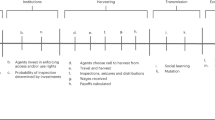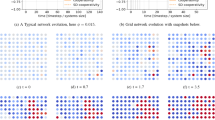Abstract
Non-state actors play an increasingly important role in environmental policy. Lobbying by interest groups has been associated with policy stagnation and environmental degradation as well as with sustainable governance. However, little is known about how competition between economic and environmental interests influences the ability of governance systems to avoid undesirable outcomes. We investigate how competing interest group behaviour affects sustainable resource management by tracing the policy change process in a case study of the European Union fisheries policy and analysing its dynamics with an agent-based model. We find that formation of interest group coalitions in response to a perceived crisis can delay or prevent collapses, even when the competing interests have unequal resources. We attribute such outcomes to the emergence and timing of a ‘tug of war’ mechanism between competing interest group coalitions. We argue that attempts to improve sustainable resource management must account for feedbacks from environmental change to behaviours of political actors.
This is a preview of subscription content, access via your institution
Access options
Access Nature and 54 other Nature Portfolio journals
Get Nature+, our best-value online-access subscription
$29.99 / 30 days
cancel any time
Subscribe to this journal
Receive 12 digital issues and online access to articles
$119.00 per year
only $9.92 per issue
Buy this article
- Purchase on Springer Link
- Instant access to full article PDF
Prices may be subject to local taxes which are calculated during checkout

Icons designed by Jerker Lokrantz/Azote






Similar content being viewed by others
Data availability
The experiment output data that support the findings of this study are available from the corresponding author upon request. ODD + D protocol model documentation is included in Supplementary Note 1.
Code availability
The NetLogo code for the PoliSEA model is available for download from the OpenABM library:
https://www.comses.net/codebases/14c54b41-7fd6-4165-a15f-f76eec53af78/releases/1.1.0/.
References
Hanna, S. S. Strengthening governance of ocean fishery resources. Ecol. Econ. 31, 275–286 (1999).
Crona, B. I. et al. Masked, diluted and drowned out: how global seafood trade weakens signals from marine ecosystems. Fish Fish. 17, 1175–1182 (2016).
Gunderson, L. H. & Holling, C. S. Panarchy: Understanding Transformations in Human and Natural Systems (Island Press, 2002).
Beyers, J., Eising, R. & Maloney, W. Researching interest group politics in Europe and elsewhere: much we study, little we know? West Eur. Polit. 31, 1103–1128 (2008).
Orach, K., Schlüter, M. & Österblom, H. Tracing a pathway to success: how competing interest groups influenced the 2013 EU Common Fisheries Policy reform. Environ. Sci. Policy 76, 90–102 (2017).
Österblom, H. & Sumaila, U. R. Toothfish crises, actor diversity and the emergence of compliance mechanisms in the Southern Ocean. Glob. Environ. Change 21, 972–982 (2011).
Raustiala, K. States, NGOs, and international environmental institutions. Int. Stud. Q. 41, 719–740 (1997).
Ingold, K. Network structures within policy processes: coalitions, power, and brokerage in Swiss climate policy. Policy Stud. J. 39, 435–459 (2011).
Folke, C., Hahn, T., Olsson, P. & Norberg, J. Adaptive governance of social-ecological systems. Annu. Rev. Environ. Resour. 30, 441–473 (2005).
Chaffin, B. C., Gosnell, H. & Cosens, B. A. A decade of adaptive governance scholarship: synthesis and future directions. Ecol. Soc. 19, 56 (2014).
Karpouzoglou, T., Dewulf, A. & Clark, J. Advancing adaptive governance of social-ecological systems through theoretical multiplicity. Environ. Sci. Policy 57, 1–9 (2016).
Lemos, M. C. & Agrawal, A. Environmental governance. Annu. Rev. Environ. Resour. 31, 297–325 (2006).
Dür, A. Interest groups in the European Union: how powerful are they? West Eur. Polit. 31, 1212–1230 (2008).
Mahoney, C. Brussels Versus the Beltway: Advocacy in the United States and the European Union (Georgetown Univ. Press, 2008).
Hojnacki, M., Kimball, D. C., Baumgartner, F. R., Berry, J. M. & Leech, B. L. Studying organizational advocacy and influence: reexamining interest group research. Annu. Rev. Polit. Sci. (Palo Alto) 15, 379–399 (2012).
Klüver, H. Lobbying in the European Union: Interest Groups, Lobbying Coalitions, and Policy Change (OUP, 2013).
Voß, J.-P. & Bornemann, B. The politics of reflexive governance: challenges for designing adaptive management and transition management. Ecol. Soc. 16, 9 (2011).
Cote, M. & Nightingale, A. J. Resilience thinking meets social theory situating social change in socio-ecological systems (SES) research. Prog. Hum. Geogr. 36, 475–489 (2012).
Duit, A. Resilience thinking: lessons for public administration. Public Adm. 94, 364–380 (2015).
Sjöstedt, M. Resilience revisited: taking institutional theory seriously. Ecol. Soc. 20, 23 (2015).
Dahl, R. A. Who Governs? Democracy and Power in an American City (Yale Univ. Press, 1989).
Lowery, D. & Gray, V. A neopluralist perspective on research on organized interests. Political Res. Q. 57, 164–175 (2004).
McFarland, A. S. Neopluralism. Annu. Rev. Politi. Sci. (Palo Alto) 10, 45–66 (2007).
Sabatier, P. A. Knowledge, policy-oriented learning, and policy change: an advocacy coalition framework. Sci. Commun. 8, 649–692 (1987).
Warleigh, A. The hustle: citizenship practice, NGOs and ‘policy coalitions’ in the European Union—the cases of Auto Oil, drinking water and unit pricing. J. Eur. Public Policy 7, 229–243 (2000).
Hojnacki, M. Interest groups’ decisions to join alliances or work alone. Am. J. Pol. Sci. 41, 61–87 (1997).
Mahoney, C. & Baumgartner, F. R. The determinants and effects of interest-group coalitions. In Annual Meeting of the American Political Science Association, Chicago (2004).
Bulkeley, H. & Mol, A. Participation and environmental governance: consensus, ambivalence and debate. Environ. Values 12, 143–154 (2003).
Dür, A. & De Bièvre, D. The question of interest group influence. J. Public Policy 27, 1–12 (2007).
Weible, C. M., Pattison, A. & Sabatier, P. A. Harnessing expert-based information for learning and the sustainable management of complex socio-ecological systems. Environ. Sci. Policy 13, 522–534 (2010).
Khalilian, S., Froese, R., Proelss, A. & Requate, T. Designed for failure: a critique of the Common Fisheries Policy of the European Union. Mar. Policy 34, 1178–1182 (2010).
Symes, D. The European Community’s Common Fisheries Policy. Ocean Coast. Manage. 35, 137–155 (1997).
Princen, S. Venue shifts and policy change in EU fisheries policy. Mar. Policy 34, 36–41 (2010).
Todd, E. & Ritchie, E. Environmental non-governmental organizations and the Common Fisheries Policy. Aquat. Conserv. 10, 141–149 (2000).
Junk, W. M. Co-operation as currency: how active coalitions affect lobbying success. J. Eur. Public Policy 0, 1–20 (2019).
Kingdon, J. W. Agendas, Alternatives, and Public Policies (Longman, 1995).
Ostrom, E. Background on the institutional analysis and development framework. Policy Stud. J. 39, 7–27 (2011).
Thelen, K. Historical institutionalism in comparative politics. Annu. Rev. Political Sci. 2, 369–404 (1999).
Fisheries management. 2: The ecosystem approach to fisheries. (Food and Agriculture Organization of the United Nations, 2003).
Dür, A., Bernhagen, P. & Marshall, D. Interest group success in the European Union: when (and why) does business lose? Comp. Political Stud. 48, 951–983 (2015).
Zimmermann, H. The European Parliament and the layered politicization of the external dimension of the Common Fisheries Policy. Politics Gov. 7, 237 (2019).
Döring, R. & Egelkraut, T. M. Investing in natural capital as management strategy in fisheries: the case of the Baltic Sea cod fishery. Ecol. Econ. 64, 634–642 (2008).
Aps, R. & Lassen, H. Recovery of depleted Baltic Sea fish stocks: a review. ICES J. Mar. Sci. 67, 1856–1860 (2010).
Baumgartner, F. R. & Jones, B. D. in Policy Dynamics (eds Baumgartner, F. R. & Jones, B. D.) 3–28 (Univ. of Chicago Press, 2002).
Biggs, R., Carpenter, S. R. & Brock, W. A. Turning back from the brink: detecting an impending regime shift in time to avert it. Proc. Natl Acad. Sci. USA 106, 826–831 (2009).
Ley, A. J. Vested Interests, venue shopping, and policy stability: the long road to improving air quality in Oregon’s Willamette Valley. Rev. Policy Res. 33, 506–525 (2016).
Pierson, P. Not just what, but when: timing and sequence in political processes. Stud. Am. Political Dev. 14, 72–92 (2000).
Manson, S. M. & Evans, T. Agent-based modeling of deforestation in Southern Yucatán, Mexico, and reforestation in the Midwest United States. Proc. Natl Acad. Sci. USA 104, 20678–20683 (2007).
Lustick, I. S. & Miodownik, D. Abstractions, ensembles, and virtualizations simplicity and complexity in agent-based modeling. Comp. Polit. 41, 223–244 (2009).
Schlüter, M. et al. Capturing emergent phenomena in social-ecological systems—an analytical framework. Ecol. Soc. 24, https://doi.org/10.5751/ES-11012-240311 (2019).
Maloney, W. A., Jordan, G. & McLaughlin, A. M. Interest groups and public policy: the insider/outsider model revisited. J. Public Policy 14, 17–38 (1994).
Hilborn, R. Managing fisheries is managing people: what has been learned? Fish Fish. 8, 285–296 (2007).
Klüver, H., Mahoney, C. & Opper, M. Framing in context: how interest groups employ framing to lobby the European Commission. J. Eur. Public Policy 22, 481–498 (2015).
Nohrstedt, D. & Weible, C. M. The logic of policy change after crisis: proximity and subsystem interaction. Risk Hazards Crisis Public Policy 1, 1–32 (2010).
Birkland, T. A. Focusing events, mobilization, and agenda setting. J. Public Policy 18, 53–74 (1998).
Hanegraaff, M. & Pritoni, A. United in fear: interest group coalition formation as a weapon of the weak? Eur. Union Polit. 20, 198–218 (2019).
Holyoke, T. T. Interest group competition and coalition formation. Am. J. Pol. Sci. 53, 360–375 (2009).
Heaney, M. T. & Lorenz, G. M. Coalition portfolios and interest group influence over the policy process. Interest Groups Advocacy 2, 251–277 (2013).
Mazey, S. & Richardson, J. Environmental groups and the EC: challenges and opportunities. Env. Polit. 1, 109–128 (1992).
Dür, A. & De Bièvre, D. Inclusion without Influence? NGOs in European trade policy. J. Public Policy 27, 79 (2007).
Lowery, D. Why do organized interests lobby? A multi-goal, multi-context theory of lobbying. Polity 39, 29–54 (2007).
Austen-Smith, D. & Wright, J. R. Counteractive lobbying. Am. J. Pol. Sci. 38, 25–44 (1994).
Rothenberg, L. S. Linking Citizens to Government: Interest Group Politics at Common Cause (Cambridge Univ. Press, 1992).
Acknowledgements
This research was made possible by the support of the European Research Council (ERC) under the European Union’s Seventh Framework Programme (FP/2007-2013/ERC grant agreement no. 283950 SES-LINK), the European Union’s Horizon 2020 research and innovation programme (ERC grant agreement no. 682472—MUSES; to K.O. and M.S.) and Marcus and Marianne Wallenberg Foundation (Grant no. 2017.0087 to A.D.). The funders had no role in study design, data collection and analysis, decision to publish or preparation of the manuscript. We would also like to thank E. Sundström for data analysis assistance.
Author information
Authors and Affiliations
Contributions
K.O., A.D. and M.S. conceived the study and designed the experiments. K.O. led development and implementation of the model, conducted experiments and analysed the data with expertise and feedback from A.D. and M.S. K.O., M.S and A.D. wrote the manuscript.
Corresponding author
Ethics declarations
Competing interests
The authors declare no competing interests.
Additional information
Editor recognition statement Primary handling editor: Stavroula Kousta
Publisher’s note Springer Nature remains neutral with regard to jurisdictional claims in published maps and institutional affiliations.
Extended data
Extended Data Fig. 1 Interest group coalition-building decision.
Interest groups’ decision to join or form coalition(s) or lobby alone.
Extended Data Fig. 2 40/10 scenario of Experiment 2.
a, Fish population, b, quota, c, average number of interest coalitions and d, influence of lobbying groups during the 40/10 scenario. The dashed line in (a) and (b) represents the concern threshold of environmental (a) and industry (b) groups. The light blue field in (b) represents seasonal catch that can be taken out to maintain current fish population size (setting a quota above this value would lead to a decrease in the fish population next season).
Supplementary information
Supplementary Information
Supplementary tables and results.
Rights and permissions
About this article
Cite this article
Orach, K., Duit, A. & Schlüter, M. Sustainable natural resource governance under interest group competition in policy-making. Nat Hum Behav 4, 898–909 (2020). https://doi.org/10.1038/s41562-020-0885-y
Received:
Accepted:
Published:
Issue Date:
DOI: https://doi.org/10.1038/s41562-020-0885-y



